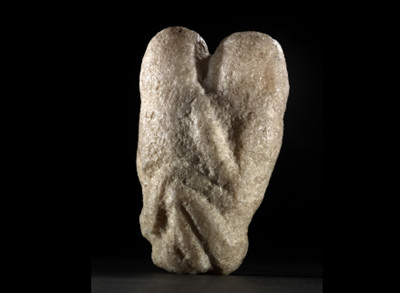(单词翻译:单击)
听力原文
But what do we know of the people captured in this lovers' embrace? Well, the maker or should we say the sculptor? of the lovers, belonged to a people that we now call the Natufians, who lived in a region that straddled what is today Israel, Palestine, Lebanon and Syria, and our sculpture came from the area south-east of Jerusalem. In 1933 the great French archaeologist Abbé Henri Breuil and a French diplomat, René Neuville, visited a small museum in Bethlehem. Neuville wrote:
但我们还可以知道关于这对拥抱中恋人的什么东西呢?这件恋人作品的工匠,也许我们应该称之为雕塑家,来自于我们今天称之为Natufian人,大概定居在现今以色列、巴勒斯坦,黎巴嫩及叙利亚那个地域上,而我们这位雕塑家来自于取路撒冷东南部的某处。1933年杰出的法国考古学家兼神甫亚布·享利·布勒伊与一名法国外交官诺伊维尔参观在伯利恒地区的一座小型博物馆。诺伊维尔记录道:
'Towards the end of our visit, I was shown a wooden casket containing various items from the surrounding areas, of which none, apart from this statuette, was of any value. I realised immediately the particular significance of the design involved and asked the source of these objects. I was told that they had been brought by a Bedouin who was returning from Bethlehem towards the Dead Sea.'
“随着我们行程接近尾声,有人向我展示了一个长木盒,装有附近地区收集来的形形色色的物品,但除了这件雕像,其他都是一些毫无价值的物什。我立即意识到这件物品的特殊重要性,并询间它的出处。人家告诉我这盒物什是一个途径死海,从伯利恒回来的贝都因人带来的。”
Intrigued by the figure, Neuville wanted to know more about its discovery and he sought out the Bedouin he'd been told about. He managed to track down the man responsible for the find, who took him to the very cave - in the Judean desert not far from Bethlehem - in which the sculpture of the lovers had been discovered. The cave was called Ain Sakhri, and so these sculpted lovers that had so captivated Neuville are still known as the Ain Sakhri lovers.
对着物品浓厚的兴趣,驱使诺伊维尔去了解更多关于它的发现过程,于是他开始去打探人们所说的那位贝都因人的下落。最后他设法找到了最初发现这恋人雕塑的那个人。那人把他带到了当初雕塑出土的那个洞穴,位于伯利恒不远的朱迪亚沙漠。那个洞穴被称之为Ain Sakhri,所以那对让诺伊维尔着迷不已的拥抱中的恋人也便称之为Ain Sakhri恋人了。
Crucially, the sculpture had been found with objects which made it clear that the cave had been a dwelling rather than a grave, and so our sculpture must have played some kind of role in domestic everyday life.
更重要的是,出土这对恋人雕像的同一洞穴里还发现了其他的物品,明确显示了这洞穴曾经是处日常居住场所,而不是一处墓葬。因此我们这件雕像作品在当时人们的日常生活中肯定起到某种作用。
We don't know exactly what that role might have been, but we do know that this dwelling belonged to people who were living at the dawn of agriculture. Their new way of life involved the collecting and storing of food.
我们不知道它究竟曾经充当了什么实际角色,但我们知道这洞穴的主人生活的时代正值农业的曙光。他们崭新的生活方式包括了惧与储存食物。
Wild grass seeds fall off the plant and are spread easily by the wind or eaten by the birds, but these people selected seeds which stayed on the stalk , a very important characteristic if a grass is ever going to be worth cultivating. They stripped these seeds, removed the husks and ground the grains to flour. Later, they would go on to sow the surplus seeds. Farming had begun and ever since, together we've been breaking bread.
野草种子通常从植物上脱落一来,然后轻易地通过风力传播,或者被鸟类吃掉,但是这些人类偏偏选择那些保留在谷物秆上的种子,这是决定某种农作物是否值得培育的重要一点。人类把这些种子采集、剥壳,然后把谷物碾磨成面粉。再后来,他们开始学会了把剩余的种子拿去播种。农业诞生了——并从那刻起,直到今天,我们仍然在烘烤面包。

重点讲解
1. belong to
属于
eg. They belong to someone.
他们肯定属于某人。
eg. There are these antichrists,and notice it says: "They went out from among us but they did not belong to us.
这里提到“敌基督的“,注意它说:,“他们从我们中间出去,却不是属我们的。
2. apart from
远离,除…之外;且不说;缺少
eg. What did you do there – apart from eating?
你在那里做了什么——除了吃以外?
eg. But then there is only one thing and nothing can exist apart from itself.
但是,只有一件事,没有任何事物能够脱离自身而存在。
3. make it clear
弄清楚
eg. You have to make it clear, if you say no, that you’re not going to change your mind.
因此如果你要拒绝的话, 你就得让别人清楚的知道你不会再改变主意了。
eg. When you put information in a modal window, you need to make it clear for your users how to close the window.
当你放信息在一个弹出窗口的时候, 你需要让你的用户清楚怎么去关闭这个窗口。


